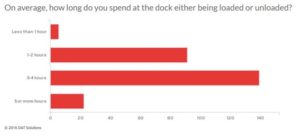63% of Drivers Are Detained More Than 3 Hours per Stop
By Matt Sullivan, Marketing, DAT Solutions
Most drivers spend 3 to 4 hours waiting to get loaded or unloaded, according to a DAT survey of 257 carriers and owner-operators. Of the carriers surveyed, 54% of them said that they wait between 3 to 5 hours every time they’re at a shipper’s dock. Another 9% said that they wait more than 5 hours on average.
You don’t have to crunch a lot of numbers to figure out how that’s bad for business

The graph above shows responses from 257 carriers surveyed
Detention fees usually range from $30 to $50 an hour after the driver has been detained for more than two hours, based on responses those same carriers plus 50 brokers who were also surveyed. And that’s if the carrier is actually lucky enough to collect a detention fee.
Two-thirds of the brokers said that they only paid detention when they were able to collect a fee from the shipper or consignee. When a broker is able to collect from the shipper, they were twice as likely to pay detention fees to the carrier.
But those fees are just a drop in the bucket compared to how much that detention time actually costs trucking companies. One owner-operator cited a $1,900 loss due to two loads he was unable to accept because of a lengthy detention at a receiver’s dock.
Truckers Choice partners with DAT to offer a special on the TruckersEdge load board to its members. Sign up for TruckersEdge today and get your first 30 days free by signing up at www.truckersedge.net/promo154 or entering “promo154” during sign up.
* This offer is available to new TruckersEdge subscribers only
About TruckersEdge®, powered by DAT®
TruckersEdge® Load Board is part of the trusted DAT® Load Board Network. DAT offers more than 68 million live loads and trucks per year. Tens of thousands of loads per day are found first or exclusively on the DAT Network through TruckersEdge.
Note: This article was adapted from DAT’s blog post on www.DAT.com. It was first published in June, 2016.
